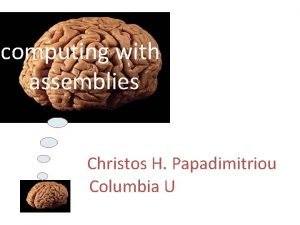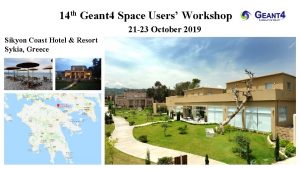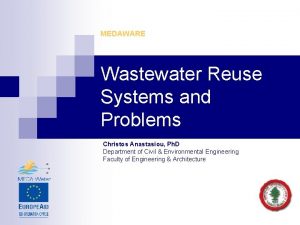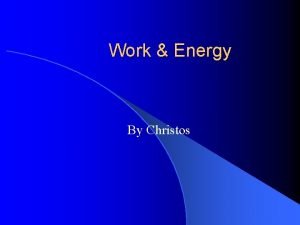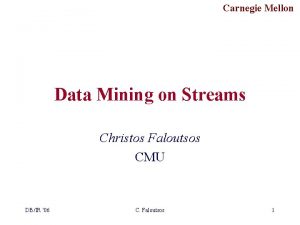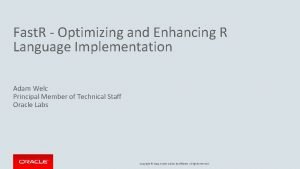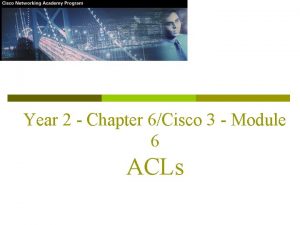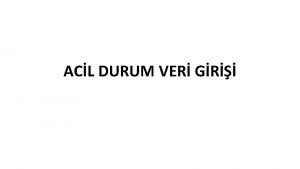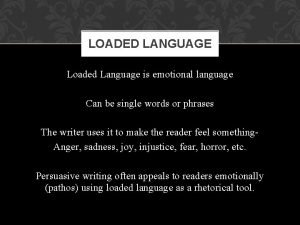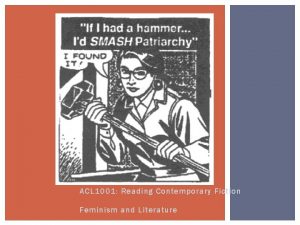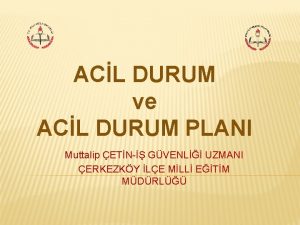Place in Literature Christos Tsiolkas Loaded ACL 1001



















- Slides: 19

Place in Literature Christos Tsiolkas’ Loaded ACL 1001 Reading Contemporary Fiction Semester 1, 2008 Lecture 5

What is place? l As a noun it could refer to l l l physical space, a garden, a city, a room, an alley way, a tree the position occupied by something or someone – for example when we speak of something occupying its proper place, we are referring to its rank, or its proper arrangement. Its order As a verb it describes the act of arranging things. l l we place cutlery on the table we place money in the bank we place someone a job, we place trust in someone.

Identification and Order l Place is a way of naming or identifying a space, an object or a person. Our sense of place gives order to the world. When we know something’s place, or we have placed it, we feel more certain about it – we can start to contextualize ourselves.

What about place in literature? l l Most obviously literature has a relationship with ‘place’ in its description of and attitude toward the physical setting of the action that takes place in the writing: l James Joyce’s Ulysses is set in the streets, houses, pubs, libraries etc of Dublin on June 16, 1904 l WG Sebald’s Vertigo is set in 19 th century and 1980 s Italy, Austria and Germany. l Don Delillo’s Cosmopolis is set in Manhattan in April 2000. Places that literature speaks to are: l Home l The city l Nations l We speak of a national literature – eg: Australian literature. Writing by those who have a connection to Australia.

Do literary places have any relationship to ‘real’ places? · · · First and foremost we should remember that the places named in literature – as far as the physical settings are concerned – are imaginary. Literary places are not continuous with the ‘real’ world except through the language we use to refer to it. I cannot meet you in the places created in the space of literature. Attempts to do this happen with festivals like Bloomsday in which participants play out the text of the novel of Ulysses in various cities around the world – including Dublin. But this makes clear that the textual city and physical spaces of the city are two different things. The festival introduces the spoken text into the city. This does not mean that we cannot still talk about the real and the imaginary in the same breath

Place as order is also important in literature. l l l l The narrating voice in literary texts will select certain events, people, objects and places to narrate. That is they implicitly select and order from the entire array of events, people and objects that is possible to narrate and how it is to be narrated. This applies from the level of each word selected to sentence structure through to the order of the plot. A narration places the text in order. Placing things in order involves preferences that are tied up with politics, gender, class and history. The Italian poet Dante Aligheri wrote The Divine Comedy in the early 14 th century. It describes the poet’s imaginary guided journey through the three mythological places of the afterlife – the Inferno (or Hell), Purgatory and Paradise. One of its chief features is its concern to place or hierarchise historical figures in their appropriate place – one of the nine circles of Hell, the seven terraces of Puragtory or the nine spheres of Paradise. The decisions made by Dante were tied up with his understanding of the complex political and moral world of 14 th century Florentine politics.

Focus on place l l What this lecture focuses on is the representation of the kind of places that most of us are familiar with – that is physical settings, particularly cities and suburbia It remains important to remember that second sense of place as order

Representations of Australian Suburbia l l l There’s a scene in the Australian ‘western’ film The Proposition written by Nick Cave when the narrative delivers us to the 19 th century outback home of Captain Stanley (Ray Winstone) and his wife Martha (Emily Watson) which sits on a neat block of land fenced off from the surrounding dusty barren land by a white picket fence. Inside the yard Martha Stanley has tried to eke out a garden of sorts. It is a sad looking affair – all rocks and pebbles and a few gaunt rosebushes. The scene played out inside the house is one of a family Christmas ritual – a roast to be shared by the couple. The emptiness and foreignness of the garden, house and ritual in the Australian setting makes a point about the desperate vulnerability of the dream of place transplanted by British colonial settlers in 19 th century Australia – the dream of ‘taming’ the country. The picture is one which implicitly critiques – even parodies – that vision of place that has come to dominate Australian life – the suburban dream. It’s a theme that has been returned to over and again in Australian literature

Kirkby on representations of Australian suburbia l l l l Suburbia is represented in Australian literature as a place of ‘repulsion and disgust, a zone of abomination’ This demonisation of suburbia is a common trope – eg George Johnston in ‘My Brother Jack’ Factory and suburbia seen as brutalizing built environments produced by modern industrialization Industrialisation separates home and workplace Domestic space becomes feminised, women are excluded from the workplace Suburbs as dormitories for factories (eg Sunshine Harvester) Kirkby identifies and sympathises with the negative portrayal of suburbia: l l ‘virulent variations of this theme have dominated the Australian imaginary, undoubtedly owing to complex, long-standing colonial anxieties about legitimacy, culture and democracy’ Most obviously this attitude toward Melbourne’s suburbs informs the heart of Christos Tsiolkas’ Loaded.

Places in Loaded l l l Bars and clubs Streets and alleyways Places that don’t materially exist l individually heightened/hedonistic internal worlds (cf: Head On) l l l The places of the imagination – of dreams/nightmares. Remembered places – nostalgised (nostos = home algos = pain) l l l dance music drugs sex Migrant homeland – places left behind or maintained within the home/suburb. Migrations also occur within the city The family home The Richmond neighbourhood Peter’s home – a place of escape

Overlapping places l Places are not seen as fixed – many sites here are contested. Some of the contestations we might like to identify are: l l l anglo and ‘wog’ straight and gay male and female public and private working class and middle class

Loaded’s attitude to Melbourne Suburbia l l l Most obviously the focus in Loaded is on what Kirkby in this week’s reading names the ‘class map of Melbourne’s suburbs’. The novel is quartered into fields of action which bring Ari through the east, north, south and west of the city. Each of these quarters gives Ari – the narrating, ordering Ari – the opportunity to reflect on a set of anxieties about class, gender, sexuality and ethnicity – fhis feelings about how people are placed in these quarters. We could compare Loaded to Dante’s Divine Comedy It is a staged journey through eastern suburban hell, the waiting room of northern suburban purgatory and the heaven of the southern suburbs This begs the question about where this leaves the west.

East l l l ‘I detest the East. The whole fucking mass of it: the highways, the suburbs, the hills, the rich cunts, the smacked-out bored cunts. The whitest part of my city, where you’ll see the authentic white Australian, is in the eastern suburbs. ’ There is no simple characterisation of the east of Melbourne – it is characterised as a placed to be loathed in toto. The dividing lines in the east of Melbourne run along ethnic and class lines. There are ‘the rich hills near the river’ and the ‘flatlands of suburban hell’. Ari does not see ‘wogs’ as a homogenous entity – in the East he sees ‘the brick veneer fortresses of the wogs with money. On the edge, however, bordering the true Anglo affluence, never part of it. ’ He sees ethnicity as a ‘scam, a bullshit, a piece of crock. The fortresses of the rich wogs on the hill are there not to keep the Australezo out, but to refuse entry to the uneducated-long-haired-bleached-blonde-no-money wog. No matter what the roots of the rich wogs, Greek, Italian, Chinese, Vietnamese, Lebanese, Arab, whatever, I’d like to get a gun and shoot them all. Bang bang. The East is hell. Designed by Americans. ’

North l l l ‘The North is where they put most of the wogs. Not in the beginning. In the beginning we clogged the inner city and the industrial suburbs of the west. But as wogs earned some money and decided to move further afield, into the bush-land-torn-down-to-becomehousing-estates, more and more concrete and brick-veneer palaces began to be sprinkled across the Northern suburbs. Wogs were not welcome to move South of the river, the brown murky Yarra which divides the city, so instead the Greeks and Italians, the Chinese and the Arabs, began to build their homes on the flatlands on the wrong side of the river. ’ (81) Again what we have here is an understanding of the economic segmentation of the city. There is an evocation of the ‘they’ – presumably the richer ruling classes – who corral the migrant working classes into a ghettoised set of communities. ‘It is a little village in the mountains of the Mediterranean transported to the bottom of the southern hemisphere. ’ ‘The North is where the wog is supposed to end up. And therefore I hate the North, I view it with as much contempt as possible’. Ari makes the rejection of place bodily in the north – seeking out casual sex partners who reflect himself. ‘In the North I find myself, find shadows that recall my shadow. I roam the North so I can come face to face with the future that is being prepared for me. On my knees, with hate written on my face, I spit out bile, semen, saliva, phlegm, I spit it all out. I spit on the future that has been prepared for me. ’

South l l l ‘To the South are the wogs who have been shunted out of their communities. Artists and junkies and faggots and whores, the sons and daughters no longer talked about, no longer admitted into the arms of family. In the South, in the flats and apartments smelling of mildew and mice are all the wog rejects from the North, the East, the West. Flushed out towards the sea. When you look straight across the ocean you look into the face of your dreams. ’ (132) This is a place more in keeping with Ari’s self conception. His concern is with ‘freedom’ with an abrogation of engagement with place. The South, a place he associates with the ‘whore’, with the pursuit of pleasure, is where he senses possibility. He casts himself in the role of the whore, he embraces the insult, the rejection. ‘To be free, for me as a Greek, is to be a whore. To resist the path of marriage and convention, of tradition and obedience. I must make myself an object of derision and contempt. Only then am I able to move outside the suffocating obligations of family and loyalty. ’ (132)

West l l Here Ari is concerned with deconstructing the mythology of community amongst the poor of the western suburbs. The west is portrayed as a place where the ‘scum’ live but a place of false consciousness – the reality of the west is not that of solidarity among the working classes but a continuation of individual and alienating competitiveness. The city is again described as a place divided along economic and ethnic lines. ‘In the working-class suburbs of the West where communal solidarity is meant to flourish, the skip sticks with the skip, the wog with the wog, the gook with the gook and the abo with the abo. Solidarity, like love, is a crock of shit. The rich don’t fear the unionised worker, they don’t fear the militant. They fear the crim, the murderer, the basher. Crime doesn’t pay, but it is the only form of rebellion open to us. And to survive thief must eschew solidarity’

Loaded and mapping narratives of place l l l l Ari is a character who enacts the literary figure of the flaneur – a stroller through the city streets whose journey maps a narrative about place. Ari, as a first person narrator, in his wandering about the city, is a kind of writer But rather than trying to determine the proper place of everything in a determined hierarchy or order (as Dante does in the Divine Comedy) he is on a journey that attempts to put the world out of place. Ari is insistent on dropping out of his place in the world – as son, as married ‘wog’ with a mortgage etc. He intends to drop out of his place by rejecting the meaning he reads in those places. Ari rejects the reification of place. His answer to the contestation and layering of place is to reject it all. He replaces received versions of the city with this act of erasure. This aligns Ari’s mission as a re-writer of the city with the French writer Maurice Blanchot’s assessment of writing as a kind of defeat of space – it creates a non-space. Mc. Mahon cites De Certeau ‘s distinction between place and space ie: place as planned and space as lived experience. Ari, in Mc. Mahon’s assessment. ‘denounces the accepted map of social organization and conformism and attempts to carve out an alternative space within and against the city. ’ (169) This latter space is dynamic, active whereas the former is static.

Ari’s reliability as narrator l l l I spoke earlier about place allowing us to know have some certainty about something, the order of things. This is essentially what is going on in Ari’s narration of the suburbs of Melbourne. The tone and purpose of this narration is for Ari to reject each place. Kirkby argues that Ari’s assertion of his negative individuality, his rejection of place reflects his disgust with the ‘brutalisation of the worker under industrial capital’ What we have to consider is the ironic distance of the narrating – Ari is a stance, he is a function of the narrative, with a selective attitude. The question we have to ask is about whether Ari is a reliable narrator. Kirkby: ‘ultimately the text is sympathetic but not complicit with Ari’s stance’

Implications of disengagement with place l l l Do we agree with Ari’s assessment of the suburbs? What implications are there for his disengagement? Kirkby writes that Tsiolkas in Loaded ‘has to some extent exaggerated the abject aspects of homo suburbiensis…poetic exaggeration of morbidity’ (18) She argues that this allows Ari to be self indulgent – the world is seen as both at fault and overwhelming – it allows Ari to excuse himself from engaging with the world. In this context Ari could be thought of as perpetuating the problems with life as he sees it. What are the implications of a mass-disengagement? Can someone like Ari disengage with the world for any longer period of time? Or will he slip into a backward looking nostalgia? As the late Ryszard Kapuscinski describes in his reading of the Iranian revolution in Shah of Shahs, people who are caught in an overdetermined and constricting environment by its timidity, and purposelessness are ‘degraded, forced into the role of an object’. The natural result of this degradation, Kapuscinski suggests, is that the nation ‘seeks shelter, seeks a place where it can dig itself in, wall itself off … it undertakes a migration in time rather than in space. In the face of circling afflictions and threats of reality, it goes back to a past that seems a lost paradise. ’
 Pengertian pemrograman terstruktur
Pengertian pemrograman terstruktur Christos h papadimitriou
Christos h papadimitriou Christos kanellopoulos
Christos kanellopoulos Christos lenis
Christos lenis Dr christos anastasiou
Dr christos anastasiou Christos chronopoulos
Christos chronopoulos Interstitiella lungsjukdomar
Interstitiella lungsjukdomar Christos markou
Christos markou Christos hatzis
Christos hatzis Christos pcb
Christos pcb Ucsb barc
Ucsb barc Christos faloutsos
Christos faloutsos Christos hatzis
Christos hatzis Christos takoudis
Christos takoudis What is the al
What is the al Christos chronopoulos
Christos chronopoulos Christos davatzikos
Christos davatzikos Christos kotselidis
Christos kotselidis Acl antibody
Acl antibody Acl ppp
Acl ppp

